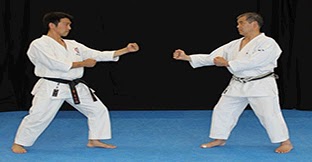The principles of Karate-do teach us
to be Non-violent. We practice to be able to control our negative emotions like
anger or fear, to swallow our pride, to respect other people and to be patient.
All such virtues are to enable us to avoid conflicts. Karate is for self defense
only and fighting should always be the last resort. The principles “Kata always
begins with a block” and “In Karate never attack first”, does not mean that we
should not strike first because there would be instances where we would need to
strike first tactically. What they mean is that we should have the mentality of
not being the aggressor, to have the attitude of avoiding conflicts and preferring
peaceful solutions. In our daily life it is very rare that we encounter
physical attacks, what we encounter more often are verbal attacks. There might
be a harsh person in your life. He or she would always shout at you, curse you,
offend or humiliate you and make your life difficult. Hopefully you have not punched the guy yet. Getting back at them, retaliate in every way, go to bed angry or sad is what we usually do. But what is the extra ordinary thing to do?
If there is a harsh person or bully in
your life, he can be your class mate, group mate, your Boss, a random angry
guy, or a co-worker who taunts you or throws his verbal attacks at you, just
deflect his attack. Let the attack pass through you and use his energy to
counter. There was a story about a Karate master who went to an inn and he was
met by a very angry guy who was jealous of him. The guy punched the Karate
master and the Karate master deflected the punch, grasped the attackers hand and
dragged him to a table and invited the guy to have a drink with him. The guy actually tried to physically harm the Karate master; but the attitude of the Karate master serves as a good example specially for verbal conflicts. There was also someone I knew who was very patient and when he heard that his older friend whom he
calls Manong was bad mouthing him, he just told us not to mind Manong because
he has a health problem and that he is already old. He was sincerely patient
and understanding of Manong.
So the first thing about deflecting a verbal attack is to check your pride and be humble. If the harsh person is shouting and cursing at you, you look at him or her and imagine that he/she is like a small toddler shouting and throwing tantrums because that is exactly how they are behaving. This way you will not be hurt because what you see is that your aggressor has the mind of a small child and that he must be dealing with far deeper issues in his life. If you have inner peace you will not
 |
| Having deflected the attack, you can choose your counter |
let yourself be affected by their negative and aggressive actions. You just let the words and the deeds go past you, and just like the Karate master you redirect and counter positively. “Sticks and stones may hurt your bones but words should never hurt you”. You deflect and let it go past you, just let it slide through. You counter not by being aggressive but by being assertive and let them know that you don’t like how he or they treat you. You counter disrespect with respect, respond to cruelty with kindness. You cannot deflect effectively and respond positively if you have fear and insecurity instead of confidence and courage. How can we have courage and confidence? Keep practicing Karate. Developing your knowledge and skills turns fear into confidence. Developing our character through practice of Karate-do turns pride or insecurities into humility and compassion. In Budo, there is no room for fear or anger because it will hinder your correct action. In our life, fear and hatred shackles our mind and spirit. We are unable to move on and unable to do the right thing. We would do or say things that we will regret.
 |
| "You control the distance, you win the fight" |
and de-stress, calm ourselves and make sure that we don’t tie ourselves down with fear or anger. Distancing ourselves from the negative person will allow us to choose better ways to react or handle the situation and a chance to recover from the hurt and get stronger. However, when we increase distance from our opponent in sparring we may be safe from attack but we also miss opportunities to attack. If we allow ourselves to stay distant, our mind and emotion may be safe from the negative person but then we will also miss the opportunity to become a better person. We will not have the compassion for that person. Be in control of how you engage or disengage mentally and emotionally because staying distant is either being afraid or prideful.
I have not yet mastered this techniques of deflecting the attack and controlling the distance. There are still instances where I would blow a fuse and say or do things that I would later regret; there are times I am unable to take a step back and breathe to be able to think more clearly and calmly before I react or speak. The process of forgiveness for me is still way too hard that it is easier to just be distant and angry. Let’s keep practicing this techniques in our daily life until they become our natural response to verbal conflicts. Keep practicing Karate-do to improve our character. Practice makes perfect.
Love your enemy.










